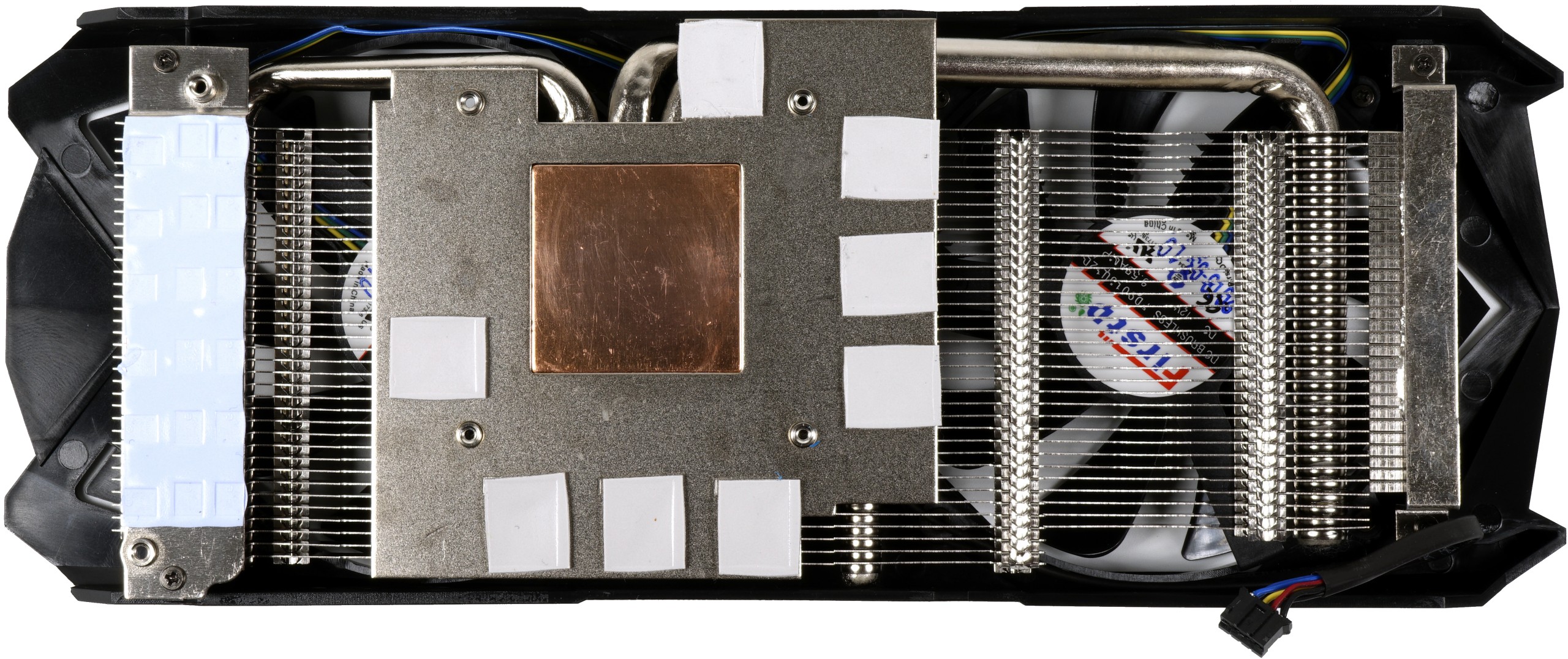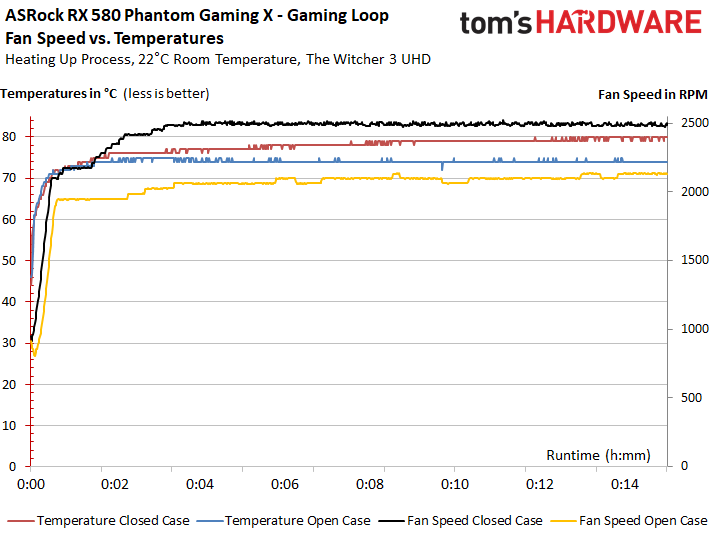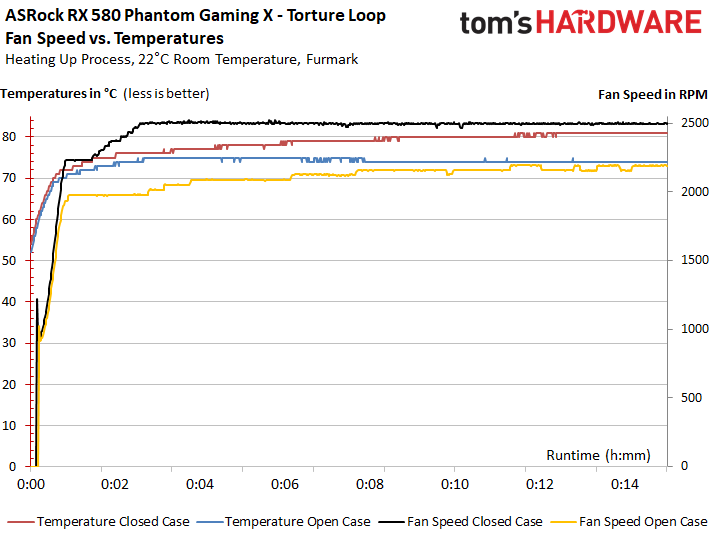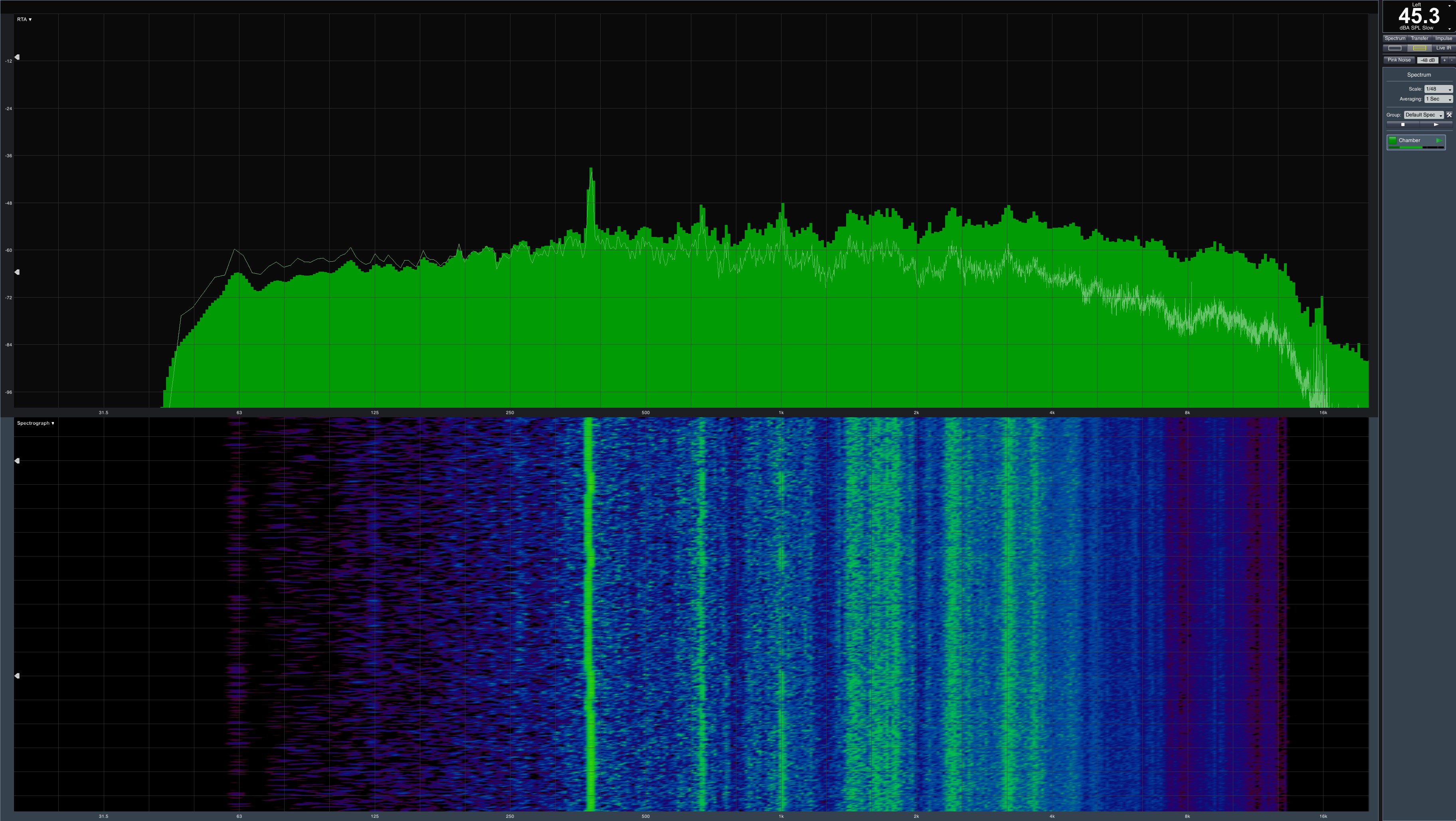ASRock Phantom Gaming X Radeon RX580 8G OC Review: A Solid Rookie Effort
Why you can trust Tom's Hardware
Cooling & Noise
Cooling Solution
There’s a direct relationship between power consumption and waste heat, and it's the thermal solution's job to cope with the latter. ASRock deliberately omits a backplate from its design, which is fine because it wouldn't have served any purpose except to look good. Thus, all of the cooling is achieved by the heat sink and fans up front.
A copper sink draws thermal energy from the GPU, while two 6mm heat pipes and a single 8mm one dissipate it through a large fin array. The base surrounding that copper block is made of aluminum, and it helps cool the memory modules through thermal pads.
Most baffling to us are the GPU and VRM sinks connected by a 6mm heat pipe. This pipe is heated from both ends, with nothing in between to cool it off. As a result, it can't be particularly efficient.
The horizontally-oriented cooling fins have quite a bit of space between them. As such, a deeper/wider sink would have been better, complemented by fans blowing air in a more turbulent manner. The way this implementation is built, fans optimized for static pressure don't cool as well.
| Cooling System Overview | |
| Type Of Cooler | Air cooling |
| GPU Cooling | Nickel-plated copper heat sink |
| Cooling Fins | Aluminum, horizontal alignmentWide, not inclined |
| Heat Pipes | 2x 6mm, 1x 8mm nickel-plated copper composite |
| VRM Cooling | Six GPU phases via dedicated VRM sink |
| RAM Cooling | Memory cooling via heat sink base |
| Fans | 2x 8.5cm fans (8.7cm opening), nine bladesSemi-passive control |
| Backplate | None |
Fan Curves & Noise
ASRock implements a semi-passive mode that remains active at idle with the card drawing ~12W. As the Phantom Gaming X warms up, its fan curve proves to be fairly conservative. After a quick ramp-up under load, the speed increase tapers off somewhat, averaging around 2500 RPM in a closed case. The Phantom Gaming X is clearly sensitive to its ambient environment, though: on an open test bench, the fans spin almost 500 RPM slower and keep the card about five degrees cooler.
The picture doesn't look much different in FurMark. In short, ASRock's thermal solution gets the job done. But its two fans also have to spin quite a bit faster in a closed case to abide ASRock's temperature target.
Again, the Phantom Gaming X's cooling solution leaves no headroom for slower-spinning fans.
Get Tom's Hardware's best news and in-depth reviews, straight to your inbox.
| Fan RPM & Noise Measurements | |
|---|---|
| Fan RPM, Open Test Bench, Maximum | 2238 RPM (Peak) |
| Fan RPM, Open Test Bench, Average | 2198 RPM (Warmed up) |
| Fan RPM, Closed Case, Maximum | 2522 RPM (Peak) |
| Fan RPM, Closed Case, Average | 2496 RPM (Warmed up) |
| Noise (Air) Range | 41.6 dB(A) (Warmed up, open test bench)45.3 dB(A) (Warmed up, closed case) |
| Noise (Air) Idle | 0 dB(A) |
| Noise Characteristics / Subjective Impressions | Slight bearing noiseSome motor noises below 1 HzModerate air and turbulence noisesHardly any voltage converter noise |
After adjusting the fans up to the speeds measured in a closed case, our acoustic equipment reports a noise output of 45.3 dB(A). That's well above the psychologically (and acoustically) important 40 dB(A) limit at 50cm. The following frequency spectrum analysis gives us a better idea where the sound comes from.
Make sure your case has good airflow. It's much easier to add a couple of quiet case fans that keep air moving than messing with the parameters of ASRock's thermal solution. In the end, though, don't expect the Phantom Gaming X to be a quiet card.
MORE: Best Graphics Cards
MORE: Desktop GPU Performance Hierarchy Table
MORE: All Graphics Content

Igor Wallossek wrote a wide variety of hardware articles for Tom's Hardware, with a strong focus on technical analysis and in-depth reviews. His contributions have spanned a broad spectrum of PC components, including GPUs, CPUs, workstations, and PC builds. His insightful articles provide readers with detailed knowledge to make informed decisions in the ever-evolving tech landscape
-
Ulikedat At least it's a looker and the competition just got a bit more heated (no pun intended).Reply -
alextheblue I have to wonder, since aiming for a cut-down budget design, why not an RX570? An entry level RX580 with halfway decent cooling can be had new for $270. The cheapest 570 I've seen is a reference model for $250. Push a budget aftermarket RX570 closer to $200 and undercut everyone else. Clocks and TDP would be lower (especially if they stuck close to reference), which would have further reduced board and cooler costs.Reply
Or perhaps yields are so good at this point, that there just aren't many cut-down Ellesmere chips getting pushed out the door? -
BulkZerker @alextheblue they are pushing the bang for buck at every point it seems. It begs to wonder if some "cheap" (like as5) thermal paste would help or not. Certainly an aftermarket heatsink would help the temps.Reply -
TJ Hooker If this card is like most 580s, it will respond quite well to lowering the core voltage. With some undervolting (and maybe a slight underclock), you could likely improve power, thermals and noise noticeably with no (or little) impact on performance.Reply -
AnimeMania What's going on with the numbers for GTX 1060 3GB with certain games like Hitman and DOOM, they can't really be that bad, can they?Reply -
Sleepy_Hollowed This is quite a nice card, especially for those looking to switch to FreeSync and the open drivers that AMD provides (For accelerating stuff like data compression or video encoding).Reply
Like all cards, I just wish it was available, this crypto craziness is on the downslope for now, but you never know when cards are just going to be missing from the shelves for months. -
Olle P Reply
Around here there's almost no price difference between a 570 (4GB) and 580 (8GB). The latter is significantly better at the all important 1080p so that's where to make profit.21064926 said:I have to wonder, since aiming for a cut-down budget design, why not an RX570? ...
One can only hope. The 180W drawn is a bit steep IMO.21065443 said:If this card is like most 580s, it will respond quite well to lowering the core voltage. ...
Seems off topic...21065545 said:What's going on with the numbers for GTX 1060 3GB with certain games like Hitman and DOOM, they can't really be that bad, can they?
The 3GB is a cut down version of the 6GB, with fewer ROPs and less memory bandwidth. 3GB VRAM is also insufficient to run newer games efficiently. -
AnimeMania Reply
According to another review on Tom's Hardware, the GTX 1060 3GB had 68.1 FPS on Hitman at Ultra Levels.21066401 said:
Seems off topic...21065545 said:What's going on with the numbers for GTX 1060 3GB with certain games like Hitman and DOOM, they can't really be that bad, can they?
The 3GB is a cut down version of the 6GB, with fewer ROPs and less memory bandwidth. 3GB VRAM is also insufficient to run newer games efficiently.
https://www.tomshardware.com/reviews/nvidia-geforce-gtx-1060-graphics-card-roundup,4724-2.html
The GTX 1060 3GB in this article had 21.2 FPS on Hitman at Very High Levels. I don't think it is off topic if I am questioning the reliability of the benchmarking process used here. I was just wondering why the results seem to fluctuate so wildly. One value is 3 times higher than the other. -
alextheblue Reply
That was my point. There's less competition for cheap RX 570s. Their 580 design cuts down on costs across the board (pun intended). They could cut down even further with the lower-TDP (and presumably cheaper) RX 570 and undercut the entire field substantially. An RX 570 at ~$200 would be enticing for budget builds.21066401 said:Around here there's almost no price difference between a 570 (4GB) and 580 (8GB). The latter is significantly better at the all important 1080p so that's where to make profit.
When they first came out there was often a substantial price difference between full Ellesmere and cut-down Ellesmere. That's why I'm speculating that there just isn't enough supply of 570 chips to make this possible.



